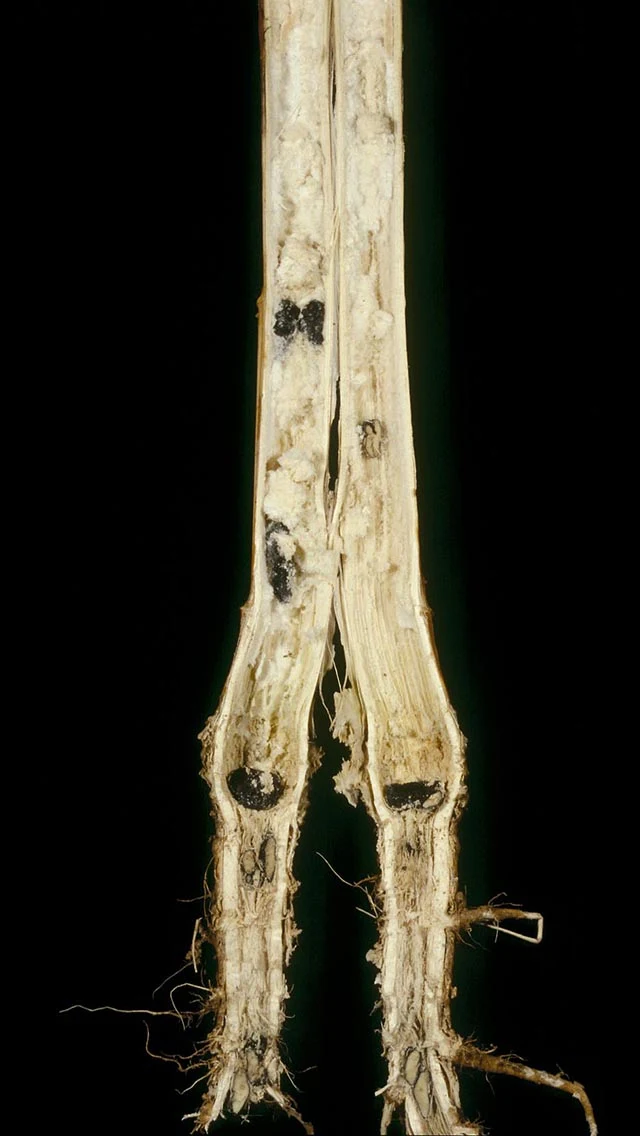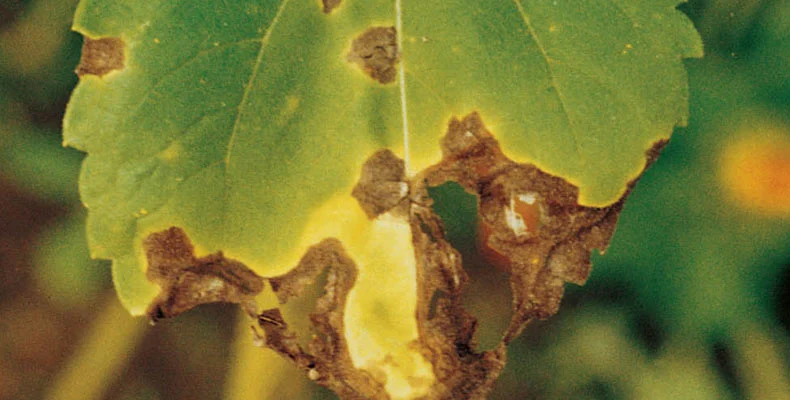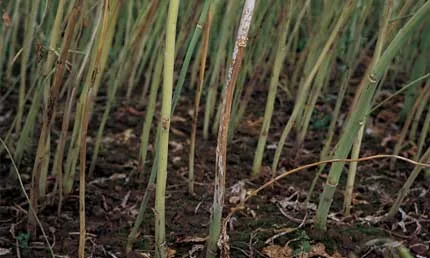
Sclerotinia
Sclerotinia sclerotiorum

Sclerotinia sclerotiorum
Sclerotia occur within the soil profile and those in surface layers germinate in spring when soil temperatures are above 10°C to form apothecia. Soils must be moist for germination to occur. These mushroom-like structures are 5mm to 15mm in diameter and produce ascospore which are discharged into the air.

Sclerotinia infected leaf
Crop are most at risk where acospores are produced within an oilseed rape crop, however some spores are dispersed more widely from other fields into surrounding crops. Ascospores land on petals and infect the plant when temperatures are above 7°C and there are long periods of humidity.

Sclerotinia infection on stems
Leaf infection occasionally occurs during the winter and this can lead to early stem infection but crops are most at risk of Sclerotinia infection from the onset of flowering. During flowering initial infection comes from mainly airborne ascospores landing on petals. The disease developes when petals fall and stick to leaves or stems with moisture from light rain.
Rotting petals provide sufficient nutrition for the fungus to penetrate the leaf cuticle resulting in pale brown or white lesions. Stem lesions develop where the pathogen spreads by mycelial growth from leaf lesions and where initial infection is in the leaf axil.
Stem lesions develop, spread up and down the stem and may be covered in white fungal growth in humid weather. When infection occurs towards the end of flowering, more lesions tend to develop on the smaller branches than on the main stem. When lesions have girdled the stem, the stems and pods beyond the lesions ripen prematurely. In lodged crops, Sclerotiniacan spread rapidly by plant to plant contact.

Sclerotia forming inside infected stems
The fungus completes its lifecycle by forming irregular black resting bodies known as Sclerotia in the stem cavity and in the roots when lesions are at stem bases. Sclerotia also form on the outside of the lesion following suitably humid weather.
With severe infection plant stems are weakened by lesions. This can cause lodging and stem splitting releasing Sclerotiaback into the soil to become the source of inoculum for future crops.
Although there is no known varietal resistance to Sclerotinia, there are other cultural options to limit its potential damage to crops. Ploughing a field after oilseed rape buries Sclerotia and impairs their ability to germinate if they can be kept deeply buried. Avoid excessive nitrogen applications so that crop canopies are not too dense or likely to lodge.
Rotation is an important tool to combat Sclerotinia; four years is the recommended interval between susceptible crops. Tighter rotations of oilseed rape have contributed to Sclerotinia problems. Peas, potatoes, carrots and other vegetable crops are all very susceptible to Sclerotinia and increase risks if grown in rotation with oilseed rape.
Proline275 (prothioconazole) gives excellent control of Sclerotinia when used as a protectant spray. Effective control relies on good spray penetration into the crop canopy. In flowering crops the aim of the spray is to coat the petals to avoid the disease penetrating the leaves or stems of the plant should these petals stick. The optimum application timing is usually prior to mid flowering, ahead of the main period of petal fall. A repeat application will be required 3 weeks later if the crop is still flowering.


